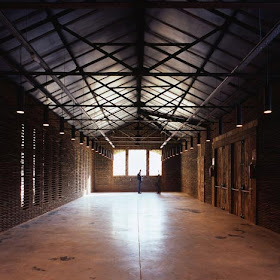A
WAREHOUSE 8B BY ARTURO FRANCO
A
WAREHOUSE 8B BY ARTURO FRANCO
The following information was provided by the architects:
In a small warehouse of the old slaughterhouse of Madrid, warehouse 8B, the tiles in bad condition have been removed from the roof, been stacked and been put inside to solve a problem. This could be the summary of the intervention.
In a small warehouse of the old slaughterhouse of Madrid, warehouse 8B, the tiles in bad condition have been removed from the roof, been stacked and been put inside to solve a problem. This could be the summary of the intervention.
A
A
Warehouse 8B will be the space destined for administrative management. It will be composed of a small working area, a stockroom and a multi-purpose space for talks or presentations.
A
A
A
The priority of the intervention was to replace a roof of flat shingle tiles over boards and successively patched thin, hollow bricks, to carry out a structural reinforcement of the whole set, and to fit out the indoors, thermally and acoustically, so as to provide service to the new uses. This process had been followed before in some other warehouses of the slaughterhouse and, as a result, mountains of tile, timber, cladding and granite slab rubble piled up waiting to be taken to the dump.
AThe priority of the intervention was to replace a roof of flat shingle tiles over boards and successively patched thin, hollow bricks, to carry out a structural reinforcement of the whole set, and to fit out the indoors, thermally and acoustically, so as to provide service to the new uses. This process had been followed before in some other warehouses of the slaughterhouse and, as a result, mountains of tile, timber, cladding and granite slab rubble piled up waiting to be taken to the dump.
A
I prefer to think that this project emerged from opportunity, from discovering an opportunity in that rubble. In the path of exploring all the reasonable possibilities, the construction system turns into a project generator, in the place where a certain ethic view on rehabilitation rests, before architecture.
AA
How does that found object work? How does the flat shingle tile work? How is it stacked? How is it bonded? What are its organoleptic characteristics, its weight? How do they join? These are some of the questions that arise during the process. The absence of some bonding elements produce lattices, the passing of light. Sometimes a whole piece for the walls, others, half a piece for the claddings. The problem of the corners, the lintels. The universal problems that architecture faces arise. At the same time and with the same intensity the workforce and imperfection appear. The imperfection of man and the old, the recovered.
A
A
It’s an intervention that intends to respect a valid spatial configuration, without adulterating it. It is proof of the power of architecture as a qualified container, independent from its uses, of the circumstantial uses. It’s a classic concept, everlasting in space, which has nothing to do with classicism, nor necessarily with Italy. Against the intended traditional “national” style that Luis Bellido applied to façades, in this case, on the inside, the style is diluted, it ceases to be heir of the old Madrid School. Order, opportunity, engagement, contention or clarity without any previous formal will. An unknown field to me, beyond the project, beyond any intention. The architect’s prominence takes a step back, it abandons architecture in time.
http://www.dezeen.com/2011/07/10/warehouse-8b-by-arturo-franco-office-for-architecture/
http://www.arturofranco.com/
Ahttp://www.arturofranco.com/
A
The recycled clay tiles were reclaimed from the warehouse roof when it was replaced.
A
A
Lines of missing tiles create narrow apertures in the partition walls.
AA
ARCHITECT ARTURO FRANCO











